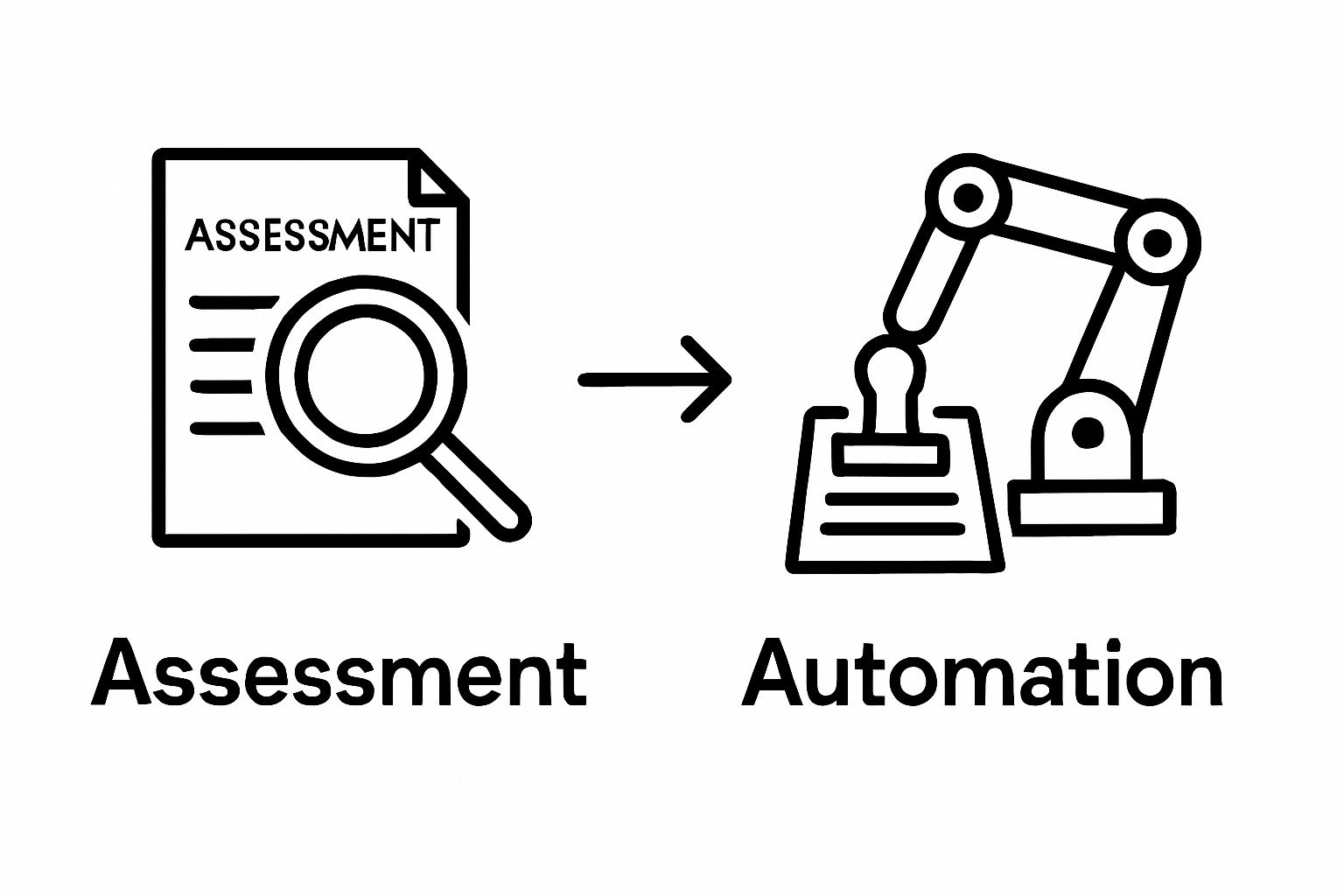30.09.25
Claims Automation Step by Step: Enhance Processing Efficiency

Insurance claims automation promises faster processing and fewer errors, but most companies still rely on outdated manual steps in their workflows. Here is something few realize. Manual data entry points and repetitive verification steps often eat up a surprising majority of staff hours. When you see just how much time is wasted on the basics, the real opportunity for improvement jumps out and changes how you think about upgrading your claims process.
Table of Contents
- Step 1: Assess Your Current Claims Process
- Step 2: Identify Automation Opportunities
- Step 3: Select Automation Tools And Technologies
- Step 4: Design Your Automated Workflow
- Step 5: Implement And Test The Automated System
- Step 6: Monitor Performance And Optimize Processes
Quick Summary
| Key Point | Explanation |
| 1. Assess Your Current Claims Process | Analyze your existing workflow to identify inefficiencies and bottlenecks. This understanding preps you for strategic automation. |
| 2. Identify Automation Opportunities | Pinpoint specific tasks to automate for enhanced efficiency. Focus on repetitive, rule-based tasks that benefit from technology. |
| 3. Select the Right Automation Tools | Carefully evaluate technologies that align with your automation goals. Prioritize user-friendly solutions that offer real-time insights and robust features. |
| 4. Design an Automated Workflow | Create a structured workflow mapping each claims process stage. Integrate technology thoughtfully to enhance efficiency and accuracy. |
| 5. Monitor and Optimize Performance | Establish a performance monitoring framework for continuous improvement. Use insights to refine processes and enhance operational effectiveness. |
Step 1: Assess Your Current Claims Process
Assessing your current claims process is the foundational step in claims automation. This critical evaluation uncovers inefficiencies, bottlenecks, and opportunities for transformative improvement across your insurance workflow. Understanding your existing process enables strategic implementation of automation technologies that deliver meaningful operational enhancements.

Begin by conducting a comprehensive process mapping exercise. Gather your claims team and document each touchpoint in your current claims handling workflow. Walk through actual claim scenarios from initial reporting to final resolution, tracking every action, decision point, and stakeholder interaction. Pay special attention to manual data entry points, repetitive tasks, and time-consuming verification steps.
During this assessment, document key metrics that reveal process performance. Measure average processing times, error rates, staff hours spent on routine tasks, and customer satisfaction scores. Look for patterns where human intervention creates delays or introduces potential errors. Some critical areas to analyze include document processing, claim validation, communication workflows, and final settlement procedures.
The table below summarizes typical metrics to document during claims process assessment, helping ensure a thorough and measurable evaluation.
| Metric | Description | Why It Matters |
| Average Processing Time | Time taken to process a claim from start to finish | Reveals bottlenecks and areas for speed improvement |
| Number of Manual Touchpoints | Count of manual interventions in a claim cycle | Indicates potential areas for automation |
| Error Rate | Percentage of claims with data entry or processing errors | Highlights where automation could reduce mistakes |
| Staff Hours on Repetitive Tasks | Total time staff spend on routine activities | Identifies opportunities to improve labor efficiency |
| Rework Requirements | Instances where claims need correction or reprocessing | Shows process complexity and points needing simplification |
| Customer Satisfaction Scores | Metrics from post-claim surveys or feedback | Reflects the impact of process changes on customer experience |
Specific evaluation techniques should involve both quantitative and qualitative analysis. Interview claims processors about their daily challenges, review historical claim processing data, and analyze system logs that capture workflow inefficiencies. Read more about transforming claims management to understand how leading insurers approach process assessment.
Successful process assessment requires honest, detailed documentation. Create a comprehensive report that highlights:
- Exact time spent on each claims processing stage
- Number of manual touchpoints per claim
- Average processing times
- Error rates and rework requirements
- Staff hours dedicated to repetitive tasks
Once you have a clear picture of your current claims process, you’ll be prepared to strategically design an automation approach that addresses specific organizational needs and challenges.
Step 2: Identify Automation Opportunities
Identifying automation opportunities is a strategic process that transforms your claims workflow from manual, time-consuming operations to efficient, technology-driven systems. This critical step focuses on pinpointing specific areas where technology can deliver substantial improvements in speed, accuracy, and overall operational performance.
Technology assessment begins with understanding your current pain points. Analyze the data collected during your initial process mapping to recognize repetitive tasks, bottlenecks, and areas prone to human error. Claims processing typically includes several prime candidates for automation such as initial claim intake, document classification, data extraction, preliminary validation, and routine communication workflows.
Concentrate on tasks that are rule-based, standardized, and high-volume. These characteristics make processes ideal for robotic process automation (RPA) and artificial intelligence integration. Common automation targets include digitizing paper documents, automatically categorizing incoming claims, extracting key information from forms, conducting initial fraud screenings, and generating standard communications.
Learn more about automation in P&C insurance to understand the broader technological landscape. When evaluating potential automation opportunities, consider both technological feasibility and potential return on investment. Some key areas to explore include:
- Data entry and document processing
- Initial claim routing and triage
- Basic eligibility verification
- Standard communication generation
- Preliminary damage assessment workflows
Successful opportunity identification requires cross-functional collaboration. Engage claims processors, IT specialists, and technology experts to develop a comprehensive view of potential automation strategies. Create a detailed matrix ranking potential automation initiatives based on complexity, implementation cost, expected efficiency gains, and potential impact on customer experience.
Verify your automation opportunity assessment by developing clear metrics. These should include projected time savings, expected error reduction, potential cost savings, and anticipated improvements in claims processing speed. A thorough evaluation ensures that your subsequent automation implementation will deliver meaningful organizational benefits.
This table provides a quick-reference overview of key claims automation opportunities, with a focus on their characteristics and potential efficiency gains.
| Automation Opportunity | Type of Task | Key Benefit |
| Data Entry & Document Processing | Repetitive, rule-based | Accelerates handling, reduces errors |
| Initial Claim Routing & Triage | Standardized decision-making | Improves allocation, speeds onboarding |
| Basic Eligibility Verification | Standardized, high-volume | Decreases manual checks, increases accuracy |
| Routine Communication Generation | Format-based, high-frequency | Saves time on customer updates |
| Preliminary Damage Assessment | Rule-based evaluations | Rapid initial assessments, early detection of major claims |
| Document Classification | Sorting and organizing | Streamlines digital workflows |
Step 3: Select Automation Tools and Technologies
Selecting the right automation tools and technologies is a pivotal moment in your claims processing transformation. This step requires careful evaluation of technological solutions that align precisely with the automation opportunities identified in your previous assessment. The goal is not just implementing technology, but integrating intelligent solutions that dramatically enhance operational efficiency.
Start by conducting a comprehensive market analysis of claims automation technologies. Focus on solutions offering robust optical character recognition (OCR), artificial intelligence, machine learning capabilities, and seamless integration with existing systems. Evaluate tools that provide end-to-end automation across document processing, data extraction, initial claim assessment, and communication workflows. Look for platforms that offer flexible configurations, scalable infrastructure, and intuitive user interfaces that minimize disruption to current operational processes.
Explore automation technologies in P&C insurance to understand the evolving technological landscape. When evaluating potential tools, prioritize solutions that demonstrate:
- Advanced machine learning capabilities
- Robust security and compliance features
- Seamless system integration
- Scalable and flexible architectural design
- Comprehensive reporting and analytics functions
Engaging multiple stakeholders during the selection process is crucial. Involve claims processors, IT specialists, compliance officers, and technology experts to ensure a holistic evaluation. Create a detailed selection matrix that scores potential technologies against key criteria such as implementation complexity, total cost of ownership, expected efficiency gains, and alignment with organizational strategic objectives.
Consider conducting pilot tests or requesting detailed demonstrations from potential technology providers. These hands-on evaluations allow your team to assess real-world performance, user experience, and compatibility with existing workflows. Verify tool effectiveness by establishing clear performance benchmarks including processing speed, error reduction rates, cost savings projections, and potential improvements in overall claims handling efficiency. The right technological solution will not just automate tasks but fundamentally transform your claims processing approach.
Step 4: Design Your Automated Workflow
Designing an automated workflow represents the critical translation of your strategic vision into a practical, operational reality. This step transforms your identified automation opportunities into a structured, intelligent process that seamlessly integrates technology with existing organizational capabilities. The goal is creating a workflow that not only reduces manual intervention but also enhances overall claims processing intelligence.
Begin by developing a comprehensive process blueprint that maps each stage of the claims journey. Start with claim intake and document precise automation points where technology can replace or augment human intervention. Focus on creating clear decision trees that outline how artificial intelligence and robotic process automation will handle different claim scenarios. Establish explicit rules for data validation, initial assessment, routing, and communication triggers that will be managed automatically.
Learn more about workflow automation strategies to understand advanced implementation techniques. Ensure your workflow design incorporates critical considerations such as:
- Intelligent document classification rules
- Automated data extraction parameters
- Predefined escalation and human intervention protocols
- Compliance and validation checkpoints
- Real-time tracking and reporting mechanisms
Collaboration is essential during workflow design. Engage claims processors, technology specialists, and compliance experts to create a holistic approach that balances technological capabilities with practical operational requirements. Develop scenario-based testing protocols that simulate various claim types and complexity levels. This approach allows you to refine workflow logic, identify potential bottlenecks, and ensure the automated system can handle nuanced processing requirements.
Verify your workflow design by establishing clear performance metrics and validation checkpoints. Create a comprehensive testing environment that mimics real-world claims processing scenarios. Measure the automated workflow against key performance indicators including processing speed, accuracy rates, error reduction, and overall operational efficiency. A well-designed automated workflow will demonstrate consistent performance, adaptability, and the ability to continuously improve through integrated learning mechanisms.

Step 5: Implement and Test the Automated System
Implementing and testing your automated claims processing system represents the critical moment where theoretical design transforms into operational reality. This phase demands meticulous planning, incremental rollout, and comprehensive validation to ensure technological solutions deliver promised efficiency gains. Your implementation strategy should prioritize controlled deployment, minimizing potential disruptions to existing claims processing workflows.
Begin with a phased implementation approach, starting with a limited pilot program that processes a small, representative sample of claims. Select claims types that are relatively straightforward and well-defined, allowing your team to closely monitor system performance and identify potential refinement areas. This controlled environment enables you to validate system capabilities, detect potential integration challenges, and make necessary adjustments before full-scale deployment.
Explore implementation strategies for insurance automation to understand best practices in technology integration. During implementation, establish comprehensive testing protocols that evaluate multiple performance dimensions:
- System accuracy and data processing reliability
- Integration compatibility with existing infrastructure
- Processing speed and efficiency metrics
- Error detection and correction mechanisms
- Compliance with regulatory requirements
Systematic testing requires creating realistic simulation scenarios that replicate complex claims processing challenges. Engage cross-functional teams including claims processors, IT specialists, and compliance experts to develop comprehensive test cases. Monitor key performance indicators such as processing time reduction, error rate minimization, and overall operational efficiency improvements.
Verify successful implementation through rigorous validation processes. Conduct parallel processing where automated and traditional manual systems operate simultaneously, allowing direct performance comparisons. Gather detailed feedback from users, track system performance metrics, and be prepared to make iterative refinements. A successful implementation demonstrates consistent performance improvements, enhanced accuracy, and tangible operational benefits that justify the technological investment.
Step 6: Monitor Performance and Optimize Processes
Monitoring performance and optimizing processes represents the continuous improvement phase of your claims automation journey. This critical step transforms your automated system from a static solution into a dynamic, self-improving mechanism that consistently delivers enhanced operational efficiency. Continuous performance evaluation ensures your claims processing remains agile, responsive, and aligned with evolving organizational needs.
Establish a comprehensive performance monitoring framework that captures granular insights across multiple operational dimensions. Implement real-time dashboards and analytics tools that track key performance indicators such as processing speed, accuracy rates, error reduction, cost savings, and overall system efficiency. Create a systematic approach to collecting and analyzing performance data, allowing your team to identify patterns, detect potential bottlenecks, and uncover opportunities for further optimization.
Explore advanced performance optimization strategies to understand cutting-edge monitoring techniques. Your performance monitoring should focus on critical metrics including:
- Auto-adjudication rates
- Claims processing time
- First-pass resolution percentage
- Error and rework rates
- Customer satisfaction scores
- Operational cost reductions
Regular performance reviews should involve cross-functional teams, bringing together claims processors, technology specialists, and business leaders. Conduct monthly or quarterly deep-dive analysis sessions that examine system performance holistically. Use these sessions to discuss emerging trends, validate existing automation strategies, and collaboratively develop targeted improvement initiatives.
Verify optimization efforts by establishing a continuous improvement protocol. Implement an iterative feedback loop that allows for rapid system adjustments based on performance insights. Be prepared to make incremental refinements, ranging from minor algorithm tweaks to more substantial workflow redesigns. A successful optimization strategy demonstrates consistent performance improvements, adaptability to changing operational requirements, and a commitment to leveraging technology as a strategic competitive advantage.
Ready to Eliminate Claims Bottlenecks and Drive Real Results?
If you recognize your organization in the struggles of manual touchpoints, slow processing times, and disconnected workflows described in our step-by-step claims automation guide, now is the perfect time to make a change. Your competitors are already modernizing claims management to speed up settlements and improve their customer experience. The path to high-performance claims processing is not just about technology, but about choosing a robust, future-proof platform that supports every stage of your automation journey.
Leverage the power of IBSuite by Insurance Business Applications. IBSuite offers advanced automation capabilities designed specifically for property and casualty insurers who need secure, scalable, and fully integrated solutions. Start reducing error rates and administrative overhead by exploring how cloud-native technology can transform your claims workflow. If you are ready to future-proof your insurance operations and drive superior efficiency, connect with IBA today and see what end-to-end digital transformation can deliver for your business.
Frequently Asked Questions
What is claims automation?
Claims automation refers to the use of technology to streamline and enhance the claims processing workflow within insurance operations, reducing manual tasks and improving efficiency.
How can I assess my current claims process effectively?
To assess your current claims process, conduct a comprehensive process mapping exercise, document each touchpoint, gather metrics related to processing times and error rates, and identify areas that require improvement.
What are the key automation opportunities in claims processing?
Key automation opportunities include initial claim intake, document classification, data extraction, preliminary validation, and routine communication workflows that are repetitive and rule-based.
What tools and technologies should I consider for claims automation?
When selecting automation tools, consider solutions with advanced machine learning capabilities, robust security features, seamless system integration, and scalability to meet your organization’s needs.
Recommended
- Automation and Artificial Intelligence in P&C Insurance
- How can pet insurers improve customer satisfaction through claims automation?
- Transforming Claims Management with IBSuite
- How can Insurers improve customer experience with modern claims processes?
- Batch Processing vs Real-Time Stream Processing